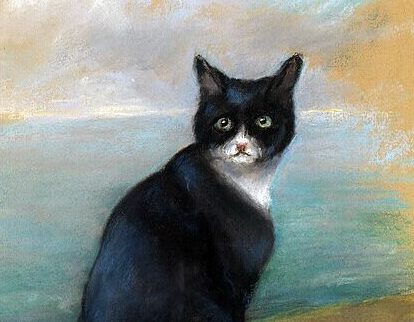You’ve heard about the Unsinkable Molly Brown, the brassy, nouveau riche millionaire mine owner’s wife who made it safely off the sinking Titanic. As incredible as that was, she had nothing on a remarkably feisty feline. Because he survived not one, but three separate ship sinkings … and in wartime, too, no less.
At least, that’s the story. Listen to it and then decide for yourself.
Meet Unsinkable Sam, the luckiest cat in the world.
It would be all too easy to make a lame reference to a cat having nine lives. Sam must have had at least twice that many.
Very little is known about his early life. He was likely born in Germany because he wound up on a German battleship in World War II. For centuries, sailors kept cats with them on the high seas, partly for the companionship, partly to go after rodent stowaways.
And he wasn’t on just any old battleship, either. It was one of the biggest, most ferocious, and potentially deadliest of all: the mighty Bismarck. She was such a grave threat that even the dauntless and determined Winston Churchill was deeply worried about her.
So when she steamed out of port in May 1941, the British made destroying her Priority 1, 2, and 3.
Bismarck quickly sank the battleship HMS Hood, causing the Brits to dispatch dozens of warships to hunt her down. When she finally went to the bottom of the Atlantic on May 26, almost 2,100 crewmen went with her. British and German vessels picked up around 115 survivors.
One of them, the destroyer HMS Cossack, spotted something clinging to a piece of debris floating in the water. On closer look, they found it was a “tuxedo cat,” black with white markings on its mouth and chest. (Think of Sylvester in the old Looney Tunes cartoons.) He was the only survivor the Cossack found.
The cat switched sides that day, going over from the Axis to the Allies. Since the Cossack’s crew didn’t know his name, they called him Oscar. It’s theorized that they called him that because in the International Code of Signals, “O” means “man overboard.
Although his allegiance had changed, his luck hadn’t.
That fall, the Cossack was torpedoed by a Nazi U-boat west of Gibraltar. She sank on October 27, almost exactly five months after the Bismarck went down.
Once again, a drenched cat was seen clinging to a piece of debris and was once more hauled aboard a British warship, the HMS Ark Royal. In a neat twist of fate, that aircraft carrier had played a key role in disabling the Bismarck the previous spring.
As word of the cat’s repeated ability to cheat death on the high seas spread, folks stopped calling him Oscar and gave him a new name: Unsinkable Sam. But the plucky feline had yet another rendezvous with Fate waiting right around the corner.
This time, it was the Ark Royal that was dispatched to Davy Jones’ Locker. Barely two weeks after the Cossack’s loss, another U-boat torpedoed the mighty carrier, also off Gibraltar.
A motor launch plucked a “quite angry but otherwise unharmed” Sam from the sea. He must have been thinking, “This is really getting old!”
That was the end of Sam’s adventures. He spent the rest of his wartime service as a mouser in the Governor General’s building on Gibraltar. He eventually wound up a “Home for Sailors” in Belfast, Northern Ireland, peacefully passing away at a ripe old age in 1955.
Historians are quick to pooh-pooh the story. They claim it’s riddled with more factual holes than the hull of the Bismarck. Serious students of World War II lump it in the “tall tales” category.
Yet, it was so widely circulated around the British Isles during the war years that it seems something involving a cat at sea must have happened.
Perhaps we’ll never know for sure. Maybe this is just one of those stories that should have been true, even if it wasn’t.


